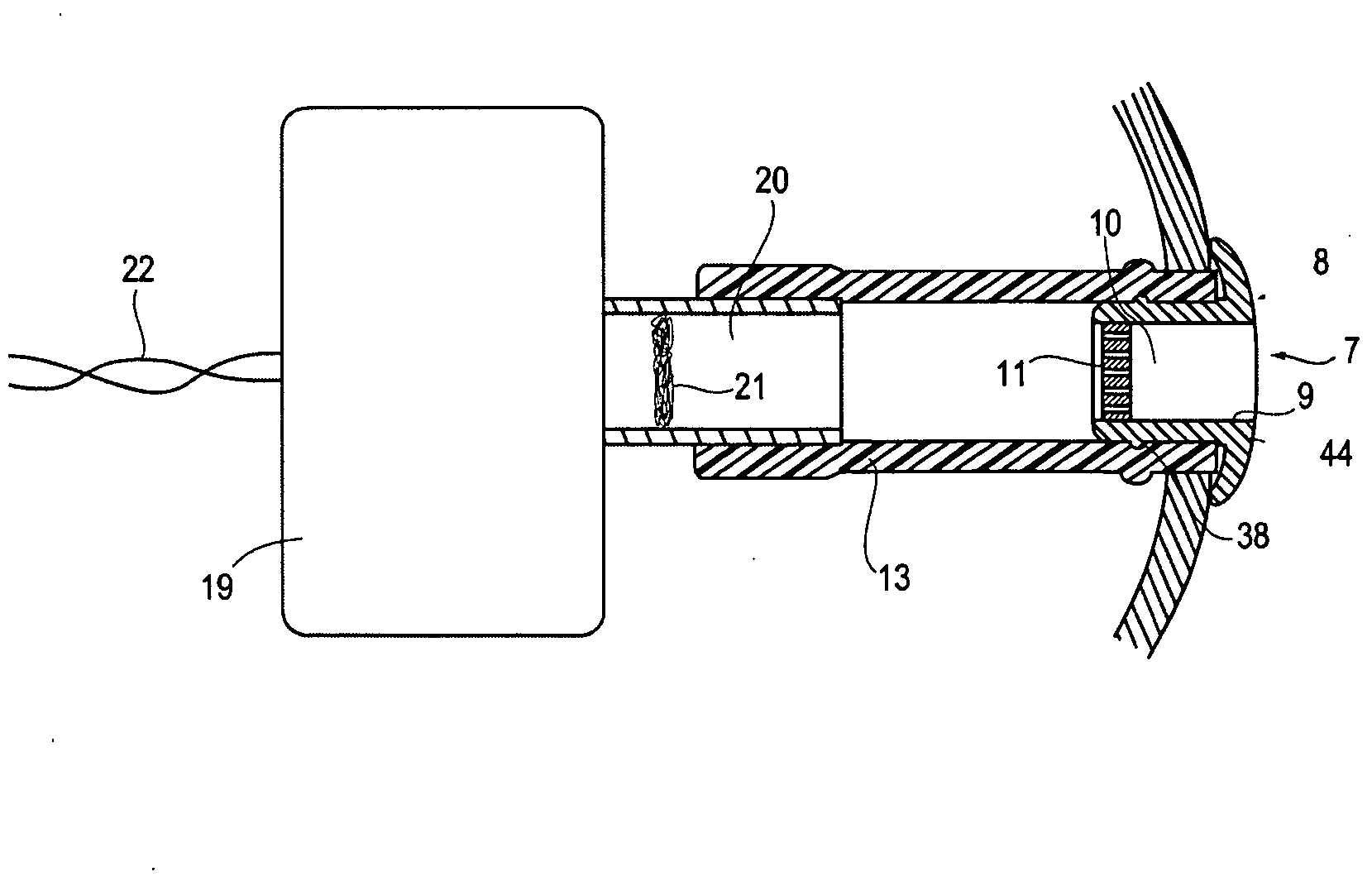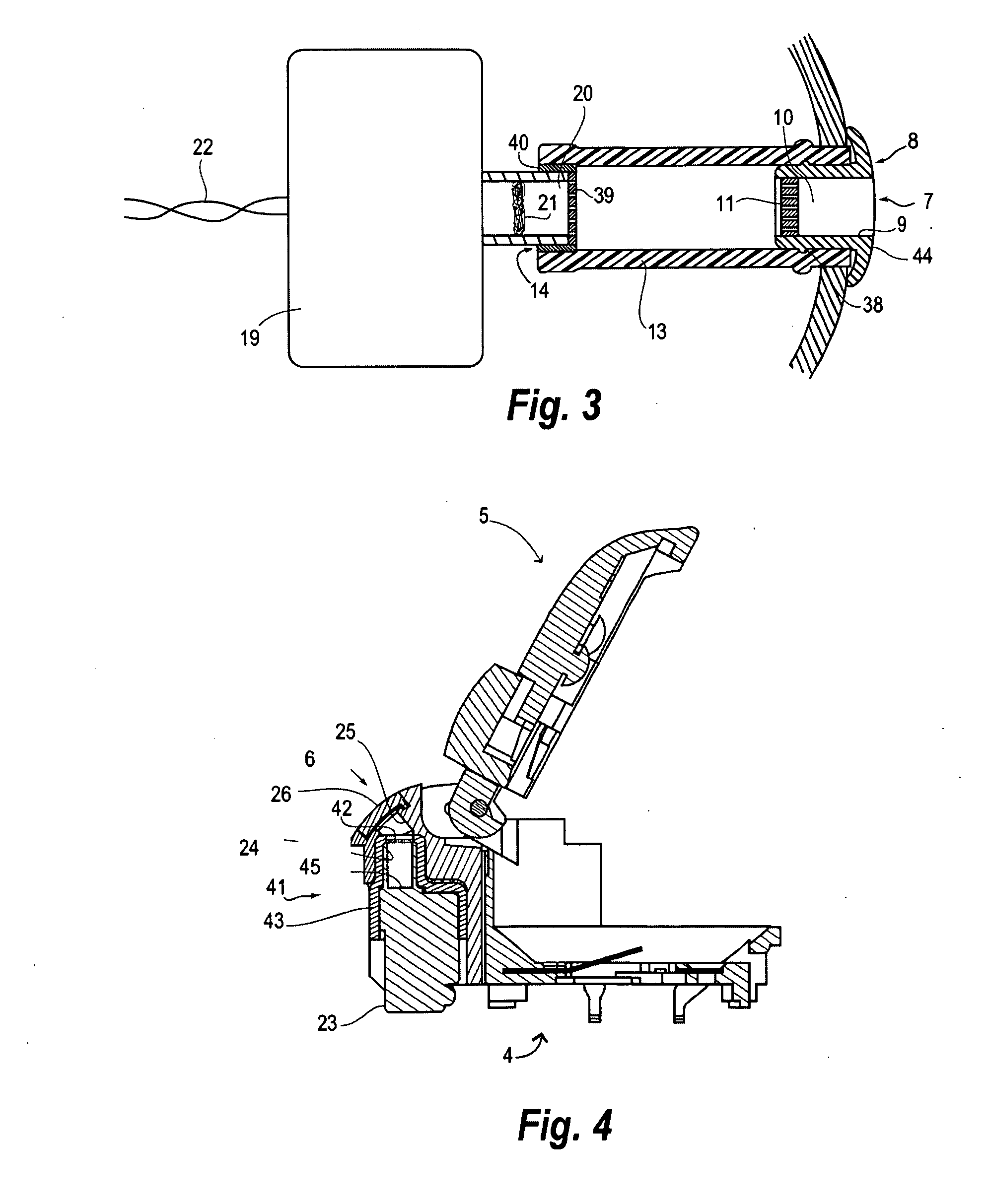Filter for a hearing aid and a hearing aid
a filter and hearing aid technology, applied in the field of hearing aids, can solve the problems of clogging and baffled acoustic output, port clogging and baffle, and the risk of earwax or moisture entering the port, so as to eliminate the risk of the barrier element getting lost, prevent the passage of fluids, and facilitate the general user's use.
- Summary
- Abstract
- Description
- Claims
- Application Information
AI Technical Summary
Benefits of technology
Problems solved by technology
Method used
Image
Examples
first embodiment
[0042]FIG. 2 illustrates the sound output segment of the hearing aid comprising a receiver body 19, leads 22 for electrical connection, a receiver stub 20, housing an acoustic filter 21, and a tube or hose 13, which connects the receiver stub 20 with an aperture in the shell 2, that defines the sound output port 7. Inserted in the hose 13 is a barrier element according to the invention, in the form of an earwax guard 8 which comprises a cylindrical body 9 having a through-going bore 10 which is partially closed at one end by an earwax retaining strainer 11. At the opposite end the cylindrical body 9 is provided with a round-going collar 44, which in the inserted position abuts against an end wall part of the shell 2. The earwax guard 8 is frictionally engaged with tube 13 by an annular bead 38 on the cylindrical body 9 and is thereby held in position during use of the hearing aid 1.
[0043]When a quantity of earwax has accumulated in the earwax guard 8 to significantly reduce the soun...
second embodiment
[0044]FIG. 3 illustrates the sound output segment of hearing aid 1 including a barrier element according to the invention in the form of a protection cap 14, which is mounted in the receiver stub 20 or in the hose 13. The protection cap 14 comprises a receiver protection strainer 39 in a supporting ring 40. The protection cap 14 serves as an additional barrier to protect the receiver from wax or sweat that for some reason enters the tube 13. This may for example happen if the earwax guard 8 falls out of the sound output port 7 during use of the hearing aid 1. Further, the presence of the protection cap 14 is advantageous in a situation where the user is out of earwax guards but still wants to use the hearing aid, or in case the user simply forgets to insert an earwax guard. The protection cap 14 will thus minimize the risk of receiver malfunction as a consequence of intruding earwax and sweat.
[0045]Contrary to the replaceable earwax guard 8, the protection cap 14 is an internal comp...
third embodiment
[0046]FIG. 4 shows a sub-assembly of hearing aid 1, mainly consisting of an electronics module 4, a microphone adaptor 41 and the lid 5. The microphone adaptor 41 comprises the sound inlet port 6, partially covered by a microphone grid 26, a sound inlet conduit 25, a microphone stub 24, a gasket 43, a microphone port 45, and a microphone 23. The microphone adaptor 41 further includes a barrier element according to the invention in the form of a microphone protection strainer 42, which is positioned in the vicinity of the microphone 23. In FIG. 4 the microphone protection strainer 42 is positioned just outside the microphone stub 24.
[0047]The strainer 11, the receiver protection strainer 39, and the microphone protection strainer 42 have surfaces which are modified to exhibit improved barrier properties towards aqueous and oily substances, as will be explained in greater detail below. The primary function of the barrier elements is to protect the receiver 19 and the microphone 23 fro...
PUM
 Login to View More
Login to View More Abstract
Description
Claims
Application Information
 Login to View More
Login to View More - R&D
- Intellectual Property
- Life Sciences
- Materials
- Tech Scout
- Unparalleled Data Quality
- Higher Quality Content
- 60% Fewer Hallucinations
Browse by: Latest US Patents, China's latest patents, Technical Efficacy Thesaurus, Application Domain, Technology Topic, Popular Technical Reports.
© 2025 PatSnap. All rights reserved.Legal|Privacy policy|Modern Slavery Act Transparency Statement|Sitemap|About US| Contact US: help@patsnap.com



